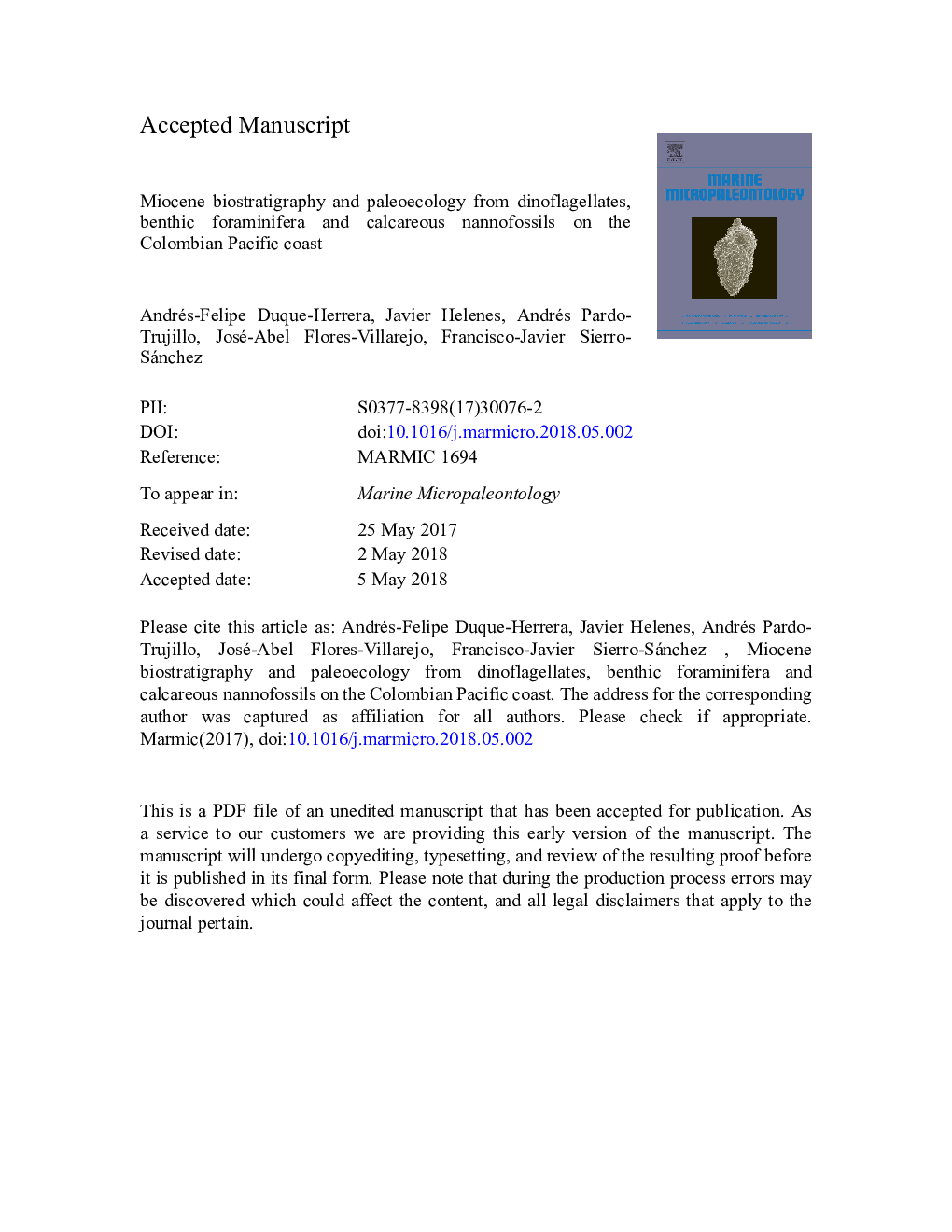| کد مقاله | کد نشریه | سال انتشار | مقاله انگلیسی | نسخه تمام متن |
|---|---|---|---|---|
| 8916496 | 1642144 | 2018 | 46 صفحه PDF | دانلود رایگان |
عنوان انگلیسی مقاله ISI
Miocene biostratigraphy and paleoecology from dinoflagellates, benthic foraminifera and calcareous nannofossils on the Colombian Pacific coast
ترجمه فارسی عنوان
بیواستراتیگرافی میوسن و پائئوسکوئولوژی از دینوفلاژل، فروامینفره بتنی و نانوفسیل های آهکی در سواحل اقیانوس کلمبیا
دانلود مقاله + سفارش ترجمه
دانلود مقاله ISI انگلیسی
رایگان برای ایرانیان
کلمات کلیدی
موضوعات مرتبط
مهندسی و علوم پایه
علوم زمین و سیارات
فسیل شناسی
چکیده انگلیسی
We present dinoflagellate assemblages contained in samples from the exploratory well Buenaventura 1-ST-P, located on the Colombian Pacific coast. The biostratigraphic model includes data from calcareous nannofossils and dinoflagellates studied from the same samples. The paleobathymetric evolution for the stratigraphic column is interpreted from its lithology, and content of benthic foraminifera and palynomorphs. We propose a chronostratigraphic framework based on the correlation of the integrated biostratigraphy, and this framework allows identification of regional tectonic and paleoceanographic events in the section studied. Our results indicate that the studied interval was deposited from early to late Miocene times (<17.9-5.33â¯Ma). The basal conglomeratic portion of the section was deposited between <17.9 and 13.4â¯Ma, and may reflect the collision of the Chocó Block with northwestern South America. These conglomerates contain very few dinoflagellates, calcareous nannofossils and benthic foraminifera. Overlying these conglomerates, ~1500â¯m of mainly shales, represent three complete transgressive-regressive (T-R) sedimentary cycles with environments ranging from transitional to upper bathyal. Autotrophic gonyaulacoid dinoflagellates dominate the lowest T-R cycle (~14.18 to <10.9â¯Ma), indicating warm and stratified superficial waters. The second T-R cycle (<10.9 to <9.53â¯Ma) is characterized by the lowest presence of marine microfossils, indicating low primary productivity. This cycle coincides with the Carbonate Crash event in the eastern tropical Pacific. Finally, the youngest T-R, from <9.53 to ~5.33â¯Ma, shows an increase in marine microfossils, and a dominance of heterotrophic peridinioid dinoflagellates, which indicate high productivity in cooler superficial waters. This cycle coincides with the late Miocene Global Biogenic Bloom event.
ناشر
Database: Elsevier - ScienceDirect (ساینس دایرکت)
Journal: Marine Micropaleontology - Volume 141, May 2018, Pages 42-54
Journal: Marine Micropaleontology - Volume 141, May 2018, Pages 42-54
نویسندگان
Andrés-Felipe Duque-Herrera, Javier Helenes, Andrés Pardo-Trujillo, José-Abel Flores-Villarejo, Francisco-Javier Sierro-Sánchez,
